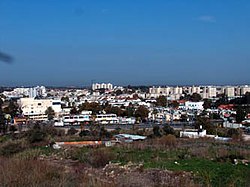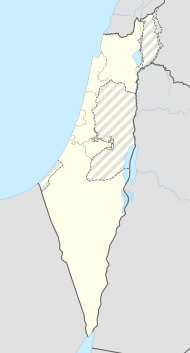Javne (city)
| Javne | ||
|---|---|---|
|
||

|
||
| Basic data | ||
| hebrew : | יבנה | |
| arabic : | يبنة | |
| State : |
|
|
| District : | Central | |
| Coordinates : | 31 ° 53 ' N , 34 ° 44' E | |
| Height : | 30 m | |
| Area : | 10,700 km² | |
| Residents : | 46,705 (as of: 2018) | |
| Population density : | 4,365 inhabitants per km² | |
| Community code : | 2660 | |
| Time zone : | UTC + 2 | |
| Community type: | City administration | |
| Website : | ||
|
|
||
Javne ( Hebrew יבנה, Arabic يبنة, DMG Yibna ), Latin : Jamnia, is a city in Israel , about 30 kilometers south of Tel Aviv .
history
Antiquity
The history of the place goes back a long way. Historic Javne has its roots in the Canaanite era (around 3000 BC). During excavations on a hill about 300 m north of the ancient city, around 2000 cult vessels from the 9th and 8th centuries BC were found. BC found, which are likely to come from a temple in the immediate vicinity. Never before has such a large amount of cult devices been discovered from the Iron Age. So far, however, only parts of the approximately 125 house models found in the pit have been published.
According to the Old Testament story ( 2Chr 26 : 6), Javne was a Philistine city that was founded around the middle of the 8th century BC. Was conquered by Uzziah and incorporated into the kingdom of Judah . In Hellenistic times, the Graecized form of the name of the place was Jamnia .
After the conquest of Jerusalem and the destruction of the temple in AD 70, the Sanhedrin (the "High Council") met in Javne around AD 72 (the so-called Sanhedrin of Jamnia ). This gives Javne an exceptional position in the history of Israel. At the same time, a Jewish school for scholars was established under the leadership of Jochanan ben Sakkai . A detailed literary appraisal of this school and its impact can be found in Lion Feuchtwanger's Josefs trilogy.
After the Bar Kochba uprising in 135 AD, the school was closed, the Sanhedrin first moved from Javne to Usha near the Bay of Haifa , and later to Tiberias . Due to the central importance of Javne for the developing rabbinical Judaism , one speaks for this time (about 70 AD to 130 AD) also of "the Javne period".
Javne Jam ( 31 ° 55 ′ 50.2 ″ N , 34 ° 41 ′ 55.8 ″ E ), about six kilometers northwest on the Mediterranean Sea near Kibbutz Palmachim , was the port of the ancient settlement. It is now an excavation site .
middle Ages
The crusaders called the place Ibelin . They built a castle in Ibelin and in 1134 the place became the center of an independent rule in the Kingdom of Jerusalem . The noble family Ibelin resident here provided numerous influential barons of the kingdom. Saladin captured the castle in 1187 and had it razed in 1191 at the latest; the place then lost its importance. A church was preserved from the time of the Crusaders .
Modern times
The present city was built in 1949, the year after the establishment of the State of Israel , on the ruins of the abandoned Arab town of Yibna for Jewish immigrants . It had the status of a developing city . From 1974 to 1987, the future Israeli Interior Minister Meir Shitrit was Mayor of Javne. On March 1, 1998, a town twinning document was signed with Speyer . This is the hundredth partnership between a German and an Israeli city. In 2001 Javne got the status of a city council . Today Javne has 46,705 inhabitants (as of 2018) and is the seat of the Israeli Institute for Nuclear Research and the electronics company Orbotech .
Residents
The Israeli Central Bureau of Statistics gives the following population figures for Javne in the censuses of May 22, 1961, May 19, 1972, June 4, 1983, November 4, 1995 and December 28, 2008:
| Year of the census | 1961 | 1972 | 1983 | 1995 | 2008 | 2015 | 2016 |
| Number of inhabitants | 5,374 | 10.100 | 13,913 | 27,445 | 32,416 | 42,314 | 44,050 |
sons and daughters of the town
- Maor Melikson (* 1984), football player
Twin cities
-
 Speyer ( Germany , Rhineland-Palatinate ), since March 1, 1998
Speyer ( Germany , Rhineland-Palatinate ), since March 1, 1998 -
 Le Raincy , Seine-Saint-Denis department , France
Le Raincy , Seine-Saint-Denis department , France
Web links
- Georg Beer : Jamnia . In: Paulys Realencyclopadie der classischen Antiquity Science (RE). Volume IX, 1, Stuttgart 1914, Col. 683-685.
- Javne City Website (Hebrew)
- Yavne: Information on Javne. Friends of Speyer
- Alexander Dubrau: Jabne / Jabneel. In: Michaela Bauks, Klaus Koenen, Stefan Alkier (eds.): The scientific Bibellexikon on the Internet (WiBiLex), Stuttgart 2006 ff., Accessed on May 29, 2012.
Individual evidence
- ↑ אוכלוסייה ביישובים 2018 (population of the settlements 2018). (XLSX; 0.13 MB) Israel Central Bureau of Statistics , August 25, 2019, accessed May 11, 2020 .
- ^ The Yavneh-Yam Archaeological Project ( English ) el Aviv University. Retrieved May 17, 2019.
- ↑ speyer.de ( Memento of the original dated December 30, 2006 in the Internet Archive ) Info: The archive link was inserted automatically and not yet checked. Please check the original and archive link according to the instructions and then remove this notice.
- ^ Israel Central Bureau of Statistics

